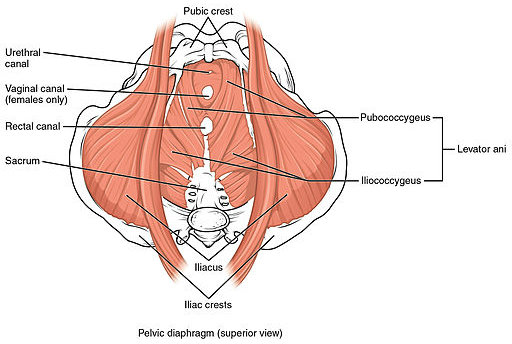 Reading Time: 9 minutes
Reading Time: 9 minutesIf you search the Internet for pelvic floor dysfunction, the reports will tell you it primarily affects women. Well, I can tell you from firsthand experience that guys are not exempt. And you or someone you love is likely dealing with the discomfort and pain of this mysterious ailment.
The story you are about to read is my own experience with pelvic floor dysfunction and how I found my way out of a miserable four months. My hope is that it will aid some of you in either identifying or managing your condition, as well. But first, a little science.
What Is Pelvic Floor Dysfunction?
Pelvic floor dysfunction (PFD) is a blanket term for numerous ailments that involve one or more of your pelvic muscles being weak, in spasm, or too tight. The issue can manifest in many ways, but is typically highlighted by pain, pressure, and incontinence. Imagine a cramping calf muscle that wakes you up out of a dead sleep. Now assign that same level of discomfort to one of the many little muscles deeply buried in your pelvis.
PFD typically affects women after childbirth, and the sufferer ends up with around-the-clock pain that can persist for days, weeks, months, or even years. The first time I heard of PFD was with a close family member who was having continual pain in her urogenital region. In women, PFD can feel like a standard urinary tract infection (UTI). My loved one spent years treating what she thought were reoccurring UTIs and only later learned she not only had PFD, but also something called interstitial cystitis — yet another miserable urogenital issue closely related to PFD.
In men, PFD and prostatitis are cousins. Prostatitis is an inflammation of the prostate that targets older men. Like PFD, the doctors have few productive ways of managing it. Unlike PFD, prostatitis is usually treated with a battery of antibiotics because the common thinking is that the ducts of the prostate have been invaded by bacteria. But this approach has statistically poor success. It is said that nearly 90% of sufferers have no change in their symptoms after a round or two of antibiotics. In many cases, prostatitis and PFD are both misdiagnosed.
My Journey with PFD
It was Easter time 2015 when I started having pain in my groin. Being a worry-wort, I spent several weeks racing around the Internet checking symptoms and trying to figure out what I was dealing with. I had been diagnosed with prostatitis three years earlier, and that came and went in about a week. I figured this was a repeat and I would be out of the woods shortly. I couldn’t have been more wrong. The pain became more aggressive and the issue seemed to move around instead of staying in one location, so I decided to get a full work-up at my doctor’s.
Here’s the kicker: my prostate was fine. After all of my labs came back, as far as my doctor was concerned, I was healthy as a horse.
As with most ailments you look up on the internet, I successfully scared the crap out of myself reading the blogs, forums, and doctor write-ups. One of the most concerning things were the posts by people who had seen multiple doctors, followed protocol for long stretches of time, and were still suffering. Given that I had been suffering for two months by this point, I began to fear I’d be one of those people who wouldn’t find a solution. The more I read, the more dejected I became. But I started to notice that when I became more upset, I experienced greater levels of discomfort.
My pain continued to move around until one day it settled into an area where no man wants to have issues. It was as if a nerve was pinched and I had continual sharp pain. After returning to my doctor and telling him we needed to do something, he connected me with a urologist. Again, another doctor who could find nothing wrong, except he decided to call my issue pelvic floor dysfunction. His solution was to send me to a physical therapist who specialized in this work — who advised spending weeks to months having painful myofascial/deep tissue work done on my crotch.
The Relationship Between Stress and PFD
Here’s where I want any of you suffering right now to listen closely. Everywhere you go to get information on PFD, you will find a laundry list of contributing factors. Most casually mention stress as one of the possible factors. These “experts” attribute some of your pain to your lifestyle and suggest stress reduction as one of the ways to manage your condition.
Dr. Chris Hardy and Marty Gallagher wrote an incredible book called Strong Medicine in which a section is dedicated to stress. As they explain, primitive man and woman needed the threat/stress response to help them get away from wild animals and impending danger. Yes, we have evolved from those states of being, but our response has not. Think about all of the low-level stressors in our lives — money, family, work. We aren’t running from bears anymore, but stresses continue to trigger a response in our daily lives. What was evolutionarily meant to be a quick explosive fix to a sudden threat followed by a quick shutdown is now an all-day existence.
If we venture outside Western medicine, then we know from chakras, dantians, and alternative medicine that the pelvis is a powerful part of the human body. Our lower region is the epicenter not only for all things physical but everything survival related. Therefore, it makes sense (if you allow it to) that a high-stress lifestyle will bring us to a tipping point of accumulated stress where the lower region of the body takes the brunt and an issue manifests.
Most “expert” websites will admit the issue is complicated and has most of Western medicine perplexed. As a result, anything that might look like pelvic floor dysfunction is thrown together into a big melting pot. And, as a sufferer, what you find out quickly is that the protocols in place rarely help anyone. I understand procedure and I get that things like bacterial infections are the first places healthcare practitioners must look, but this cycle of unsuccessful standards keeps sufferers in pain.
My PFD Prayers Answered
The more I read, the more I realize the role stress might be playing in my condition. In truth, if you look at most chronic illnesses, stress is a huge factor. Given my background in Medical Qigong, I began a rigorous schedule of Qigong self-practice to ease my pain. I found immediate relief, but not total. I spent two more months continuing this self-treatment and trying to get my life back – and then I met Paige Bartholomew.
My background is wide-scoped and I have an enormous interest in everything spiritual. I love people of faith and I have studied countless religions and spiritual systems. One of the most incredible groups of believers I have encountered are Sufis. I will summarize Sufism this way: these people have given themselves over entirely to God or the Truth. They spend every waking minute in a form of prayer or devotion and are in communion with their Creator at all times.
I know I was the person who found Paige Bartholomew, but I am inclined to say she found me. I had seen an episode of Oprah’s Super Soul Sunday where she interviewed Sufi mystic Llewwllyn Vaughan-Lee and it ignited my interest in Sufism. I bought some books and was trying to immerse myself in their ideas. Then, by chance one of Paige’s posts appeared in my Facebook feed. Paige is a Sufi Master Teacher, Licensed Psychotherapist, and Certified Hypnotherapist based out of Texas. She was advertising a meditation she sells called Clearing Anxiety. A 32-minute guided meditation intended to radically reduce your stress and eradicate anxiety.
At this point, I had been in pain for over four months — a continual pain that never ceased. I had administered more NSAIDS and muscle relaxers than a person should and attempted self-therapies I don’t even want to talk about. I was reaching levels of desperation and was fearful I would be living with this pain for the rest of my life. I downloaded Paige’s meditation and excused myself to my bedroom.
Thirty minutes later I was out of pain. Gone.
When I say gone, I mean gone. The pain never came back. I had spent over four months in hell, and in one session I was able to free myself. I was so stunned by the success I had to reach out to Paige by email and thank her. We have exchanged messages here and there over the past year now, and I can tell you she is one of the most generous, beautiful people I have ever come into contact with.
The Truth Is the Truth
The purpose of this article is two-fold: first, the world needs to know about Paige and the work she is doing. There are millions of people out there who call themselves healers, but I will attest that Paige Bartholomew is that and more. (By the way, you can follow her on Facebook.)
The second purpose is so that those who are suffering with pelvic floor dysfunction, prostatitis, or any of the other mystery ailments that Western medicine is struggling to solve understand the role stress plays. It would be reckless of me to state that stress is the lone cause of your issue, so I won’t. But it would be reckless of me not to highlight stress as one of the prevailing issues keeping you in pain. What’s even worse is that experts tell you to reduce your stress, but don’t give you a game plan on how to do it.
The beautiful thing about the alternative medical community is they are looking in places Western medicine has neglected. I have always said if Eastern and Western practices could get together, leave their egos at the door, and have a giant summit, then we would have a complete system of care. Unfortunately, both sides are entrenched in their own agendas and would rather tell everyone why the other side is wrong than open their minds to the potential each holds.
For me, I tried the Western approach, but the ultimate solution to my pain was a guided meditation. Paige guided me through an encounter with my “higher self” and through that interaction, my issue was located, removed, and resolved. I didn’t have a physical issue — I had an energetic/spiritual problem that was manifesting in my physical body. This might be difficult for some of you to hear, but if you are chasing your pain with physical solutions and not finding a resolution, then your issue may be something emotional or, even bigger, spiritual.
You have to find a way to manage your stress. We aren’t all the same and we are all dealing with different triggers that send us into our own unique spirals. If what you are doing is not helping, then try exercise, nutrition, meditation, Qigong, or Tai Chi, or find a healer like the one I found. Look into the things causing your stress and do your best to eliminate them. Life is too short and too wonderful to be living in pain.
Pelvic floor muscles by OpenStax College [CC BY 3.0], via Wikimedia Commons.






